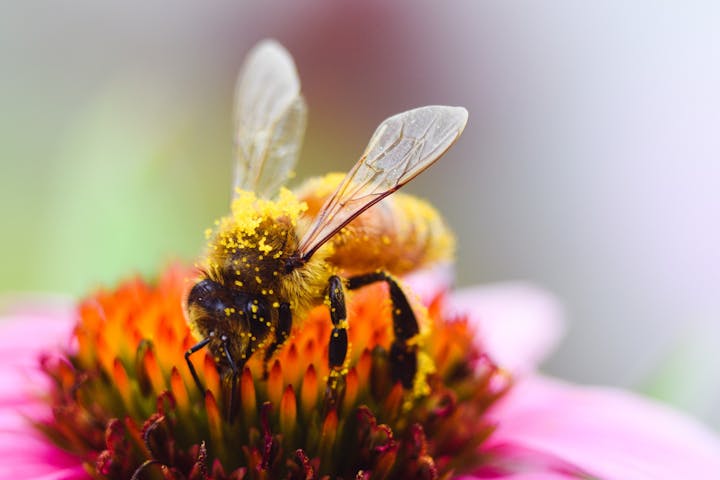Supporting Native Habitat
Native landscapes effectively clean water and air. They reduce flooding and help control erosion.
Natural areas are desirable amenities that can help define community identity. Studies have shown that natural areas enhance the economic value of residential properties.Tax-paying businesses are attracted to communities with high "quality of life".
.jpg?ixlib=rb-1.1.0&w=2000&h=2000&fit=max&or=0&s=c6b55ee04c6f018c3cf919f2e520e099)
Recreational activities support businesses, such as photography, outdoor equipment, fishing, and hunting supply industries.
Natural areas enhance the quality of life for people by providing opportunities for exercise, recreation, and solitude. Many psychologists believe that humans require contact with nature for emotional health and well-being.
Natural areas are homes, or habitat, for wildlife. Habitat provides wildlife water, food, shelter, nesting sites, and space to live. Native habitats support insects, birds, bats, and other animals that pollinate crops and control pest infestations.
The variety of life supported in natural areas preserves genetic diversity, which helps maintain evolutionary processes and stores genes that are potentially beneficial to humans.
What Can Be Done To Sustain Native Habitats?
- We can reduce human impacts through personal action and stewardship.
- We can help preserve and restore important native landscapes.
- Practicing responsible development and planning techniques.
Preserve and Restore Habitat
Preserve
Native landscapes have been fragmented and dramatically reduced in size. Clearly, the most pressing threat to habitat is conversion to other land uses. Local native habitat lands are also some of the most potentially valuable real estate properties in the United States. As we come to understand the relationship between land use, transportation, and the environment, we must seek new ways to grow
How do we provide homes and food for people, and at the same time, retain habitat for wildlife?
Sustainable development = Using land efficiently
Communities must plan land use based on current resource data and scientific understanding. Then, communities must use land efficiently, directing urban development in ways that preserve important natural areas and prime farmlands.
This is where community support is essential. You can help.
Riverside County is coordinating regional planning efforts to guide future land use decisions and to locate future transportation corridors. Large blocks of habitat with threatened and endangered species are prioritized in a Multi-Species Habitat Conservation Plan (MSHCP). Eventually, when adequate funding becomes available, we expect those prioritized native habitats will be purchased and preserved.
The Southern California Association of Governments (SCAG), is inviting public participation in creating a vision for the future. Their planning project, Southern California Compass, asks you to participate in public workshops that allow you to distribute home and jobs across the region, decide where transit lines should go, what new roads are needed, and what places should be preserved as parks.
There are several things you can do to get involved right now.
Municipalities are also reevaluating their growth plans. Current planning processes involve broad partnerships of landowners, government agencies, and conservationists. Everyone is encouraged to participate in planning and preservation efforts.
Some land conservation organizations work to acquire and preserve important properties. If you would like to help, join a local conservancy and volunteer, such as the Riverside Land Conservancy (RLC). If you own land that you would like to see preserved, consider creating a conservation easement or donating to a local land conservancy.
Planning Strategies
Prevent habitat fragmentation. Isolation of habitat areas can be prevented by planning for corridors (connections) between pockets of habitat and between different types of habitat. Corridors provide wildlife room to roam for access to food, territory, and mating. A broad range of habitat is necessary for the dispersal (gene flow) of plants and animals. A decrease in dispersal can lead to excessive inbreeding, smaller populations, and lower genetic diversity. These factors lead to extinction of species.
There are many planning strategies that can be used by governments and developers to better blance the demands of growth with habitat preservation:
- Prohibit construction in and near waterways.
- Prevent the filling of tributaries, including dry washes and arroyos.
- Sustainable development prohibits encroachment on important native landscapes and dedicates land for adequate buffers, especially around waterways.
- Prevent urban sprawl: dispersed, auto-oriented, low-density growth.
Communities can reduce demand for urban land by practicing sustainable development, Smart Growth, which directs development in ways that preserve native habitats and important farmlands.
Learn more about Smart Growth and quality of life considerations in the Urban Areas land use section.
Restore Habitat

Communities and landowners can repair degraded habitat. Potential improvements vary depending upon existing site conditions, but might include:
- removing exotic (non-native) plant and/or animal species and re-establishing natives;
- replacing fences that limit wildlife access and migration;
- closing unnecessary roadways and trails to control access and erosion;
- removing limited amounts of vegetation for habitat improvement or fire management, but also preventing unnecessary clearing and pruning, while leaving snags, dead limbs, and leaf litter in place;
- prohibiting grading, compaction, and trenching near oak root zones;
- directing irrigation runoff away from oak woodland, coastal-sage-scrub, or chaparral vegetation.
If you are interested in becoming involved with habitat restoration, contact your local Resource Conservation District (RCD) to learn about groups and projects in your community.
If you are a landowner of a natural area and would like help assessing your habitat, contact your local RCD or the USDA Natural Resources Conservation Service for free assistance.
Attempts at creating new habitat to mitigate for habitat removal, are complicated, costly, and frequently unsuccessful. Our best option is to preserve and restore the habitats we have.


